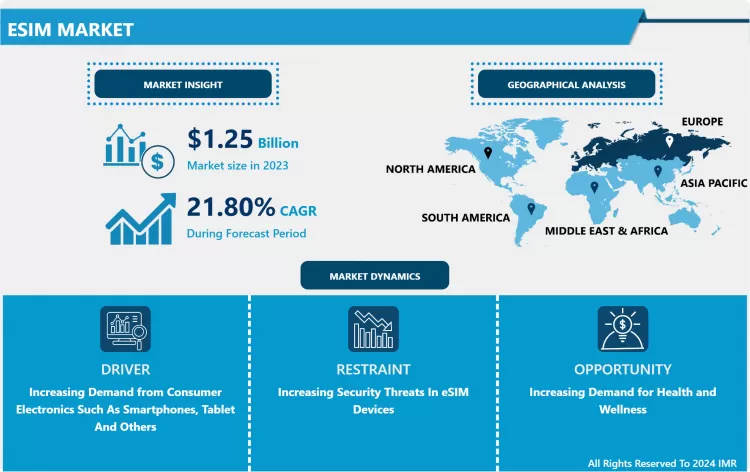eSIM Market Synopsis
Global eSIM Market size was valued at USD 1.25 billion in 2023 and is projected to reach USD 7.73 billion by 2032, growing at a CAGR of 22.43% from 2024 to 2032.
An eSIM (embedded SIM) is a digital SIM card built directly into a device, eliminating the need for a physical SIM card. It allows users to activate and manage mobile plans remotely without physically changing a card. eSIM technology is increasingly found in smartphones, wearable devices, IoT (Internet of Things) devices, and automotive systems, offering flexibility and enhanced connectivity.
- The global eSIM market is experiencing robust growth, driven by the rising adoption of IoT devices, connected wearables, and automotive solutions. As industries embrace digital transformation, eSIM technology enables seamless connectivity, reduced logistics costs, and enhanced device security. Leading mobile network operators and device manufacturers are collaborating to integrate eSIM capabilities into a wider range of consumer and industrial products.
- The Asia-Pacific region is a significant contributor to the eSIM market’s growth due to rapid technological advancements and the rising adoption of smart devices. Europe and North America also lead in market share, driven by strong demand in sectors like automotive, telecommunications, and consumer electronics. Additionally, government initiatives promoting digital ecosystems and smart cities are further accelerating the adoption of eSIM technology.
- Despite its advantages, the market faces challenges such as limited support for foreign eSIMs and software-related constraints in some devices. However, continuous advancements in remote SIM provisioning and partnerships among stakeholders are addressing these limitations. The increasing demand for streamlined connectivity solutions positions eSIM technology as a cornerstone of future mobile connectivity.

eSIM Market Key Players:
- Telefónica
- Semtech Corporation
- Giesecke+Devrient GmbH
- AT&T, Orange
- Arm Limited
- KORE Wireless
- Workz
- Oasis Smart-SIM
- Vodafone Group
- STMicroelectronics
- Thales
- Deutsche Telekom AG
- NXP Semiconductors
- Infineon Technologies AG
- Telit
- IDEMIA
- TP Global Operations Limited
- Sinch
- Singtel
- Etisalat
- Other major players.

The eSIM Market Trend Analysis
Increasing Demand from Consumer Electronics Such as Smartphones, Tablets and Others
- The increasing demand for consumer electronics, such as smartphones, tablets, and other connected devices, serves as a significant driver for the eSIM (embedded Subscriber Identity Module) market. This demand is propelled by several key factors that highlight the transformative impact of eSIM technology on the consumer electronics industry.
- eSIMs offer unparalleled convenience for users of these devices. Unlike traditional physical SIM cards, which require manual insertion and removal, eSIMs are embedded within the device during manufacturing. This means that consumers can easily activate their mobile plans and switch carriers without the need for physical SIM card swaps. This flexibility is particularly appealing to smartphone and tablet users who value the ability to switch between different mobile carriers or plans to find the most suitable options for their needs, whether it's for cost savings, improved network coverage, or international travel.

- Moreover, the eSIM's ability to support multiple profiles on a single device is a game-changer for consumers. It enables the seamless management of multiple phone numbers or data plans on a single device, eliminating the need to carry multiple devices for work and personal use. This functionality is highly coveted by professionals and business users who rely on smartphones and tablets for both personal and work-related communications and applications.
- In addition, the trend toward slimmer and more compact designs in consumer electronics benefits from eSIM integration. With no need for a physical SIM card slot, device manufacturers can create sleeker, more space-efficient designs. This contributes to the overall aesthetics and ergonomics of smartphones, tablets, and other devices.
- Furthermore, eSIM technology aligns with the broader push for sustainability in the electronics industry. It reduces the consumption of plastic SIM cards and packaging, thereby reducing e-waste and environmental impact.
Increasing Demand for eSIM Devices From M2M Application
- The increasing demand for eSIM devices from Machine-to-Machine (M2M) applications represents a significant opportunity for the eSIM market. M2M applications involve the communication and data exchange between interconnected devices and systems without human intervention. This sector spans a wide range of industries, including IoT (Internet of Things), industrial automation, healthcare, smart cities, and more. Several factors contribute to the growing importance of eSIM technology in M2M applications and how it presents opportunities within the market.
- The scalability and remote management capabilities of eSIMs make them ideal for M2M deployments. In large-scale IoT networks, managing and swapping out physical SIM cards for each device can be logistically challenging and costly. ESIMs allow for over-the-air provisioning, activation, and configuration, enabling easier and more cost-effective management of M2M device connectivity on a massive scale. This is crucial for industries like agriculture, logistics, and utilities, where thousands or even millions of devices need to be connected and monitored efficiently.
- The long lifecycle of M2M devices often outlasts the typical two-year contract associated with traditional SIM cards. ESIMs, which can be reprogrammed and reused, offer a sustainable solution for these applications. This not only reduces waste but also provides cost savings over time, as there is no need to replace physical SIM cards when devices are upgraded or repurposed.
- Moreover, the security features inherent to eSIM technology are vital for M2M applications, where data integrity and confidentiality are paramount. ESIMs offer robust security measures, including remote SIM provisioning and strong authentication protocols, to protect sensitive information in critical industries like healthcare, financial services, and smart infrastructure.
- The demand for eSIMs in M2M applications extends beyond traditional sectors. Emerging technologies like autonomous vehicles and smart grids rely on M2M communication, driving the need for reliable and scalable connectivity solutions. ESIMs play a pivotal role in ensuring seamless, secure, and efficient data exchange in these advanced applications.
eSIM Market Segmentation Analysis
eSIM Market segments cover the Component, Application, and Vertical. By application M2M segment is Anticipated to Dominate the Market Over the Forecast period.
- The M2M (Machine-to-Machine) application segment is emerging as a dominating force in the eSIM (embedded Subscriber Identity Module) market, reshaping the landscape of connectivity solutions across various industries. This dominance is attributed to the unique demands and requirements of M2M applications, which align closely with the capabilities of eSIM technology.
- One of the key factors driving the prominence of M2M in the eSIM market is scalability. M2M deployments often involve vast networks of interconnected devices, ranging from sensors and meters to industrial machinery and vehicles. Managing traditional physical SIM cards across these networks can be logistically challenging and cost-prohibitive. ESIMs provide an elegant solution by allowing remote provisioning and management of connectivity, simplifying the activation and configuration of devices on a massive scale. This scalability is crucial in industries like logistics, agriculture, and smart cities, where the efficient operation of a multitude of devices is paramount.
- The longevity of M2M devices is another factor amplifying the role of eSIMs. Many M2M devices have lifecycles far exceeding the typical two-year contract associated with physical SIM cards. ESIMs, being programmable and reusable, offer a sustainable alternative. This not only reduces e-waste but also delivers cost savings over time, as there's no need to replace SIM cards when devices are upgraded or repurposed.
- Security is a paramount concern in M2M applications, particularly in critical sectors like healthcare, finance, and infrastructure. eSIMs offer advanced security features, including robust authentication protocols and remote SIM provisioning, ensuring the integrity and confidentiality of data exchanges in M2M networks. This heightened security is a crucial aspect of eSIM technology that resonates strongly with industries that demand trustworthiness.
eSIM Market Regional Analysis
Europe is dominating the Market Over the Forecast Period.
- Europe was emerging as a leading and dominant region for eSIM adoption. Several factors contributed to Europe's prominence in the eSIM market.
- Europe was at the forefront of regulatory initiatives that promoted eSIM adoption. European regulatory bodies have been proactive in encouraging the implementation of eSIM technology, which created a favourable environment for its growth. Regulations, such as the European Electronic Communications Code (EECC), facilitated consumer access to eSIM-enabled devices and services.
- Europe's strong presence in the automotive sector played a significant role. The region is home to many leading automobile manufacturers who have been integrating eSIM technology into connected cars and vehicles. This trend was driven by the demand for advanced telematics services, in-car connectivity, and over-the-air software updates, which all leverage eSIM capabilities.
- Furthermore, Europe's robust IoT ecosystem contributed to eSIM adoption. The continent saw substantial deployments of eSIMs in various IoT applications, including smart meters, healthcare devices, and industrial automation. The ability of eSIMs to facilitate remote provisioning and management of IoT devices aligned well with the needs of these industries.
COVID-19 Impact Analysis on eSIM Market
Due to COVID-19 pandemic, several industries have witnessed significant shift in their business. There has also been significant impact on the growth of eSIM market as manufacturing operations were temporarily suspended across many countries to contain the coronavirus. Furthermore, shortage of 5G chipsets in the market disrupted the production so many manufacturing companies such as Samsung, Xiaomi, OPPO and LG Display had suspended their manufacturing operations in China, India, South Korea and in European countries. For instance, in May 2020, OPPO Company shut down its operations in Noida, India as six employees tested positive for COVID-19. Hence, demand for eSIM devices has decreased due to lockdown imposed in several countries.
Key Industry Developments in the ESIM Market
In December 2024, BSNL made significant strides in modernizing its services and infrastructure with the launch of its much-anticipated eSIM services in March 2024, aligning with global telecom standards. This initiative was part of the company’s broader strategy to remain competitive in the evolving telecommunications landscape. The introduction of eSIM technology enhanced user convenience by eliminating the need for physical SIM cards, allowing users to switch networks and activate services remotely. It proved especially beneficial for smartwatches, IoT devices, and eSIM-compatible smartphones.
In September 2024, Trasna Holdings, specializing in IoT communications, expanded its capabilities in the IoT sector by acquiring Workz, a pioneer in cloud-based eSIM solutions. The acquisition positioned Trasna as a leading provider of mobile IoT technologies, including SIM, eSIM, and SoC. Headquartered in Ireland with operations across Europe, Trasna gained enhanced expertise in eSIM and SIM hardware, software, and data management. Workz, recognized for launching the first certified cloud-based eSIM management service, served over 150 network operators globally
|
ESIM Market |
|||
|
Base Year: |
2023 |
Forecast Period: |
2024-2032 |
|
Historical Data: |
2017 to 2022 |
Market Size in 2023: |
USD 1.25 Bn. |
|
Forecast Period 2024-32 CAGR: |
22.43 % |
Market Size in 2032: |
USD 7.73 Bn. |
|
Segments Covered: |
By Component |
|
|
|
By Application |
|
||
|
By Vertical |
|
||
|
By Region |
|
||
|
Key Market Drivers: |
|
||
|
Key Market Restraints: |
|
||
|
Key Opportunities: |
|
||
|
Companies Covered in the Report: |
|
||
INTRODUCTION
RESEARCH OBJECTIVES
RESEARCH METHODOLOGY
RESEARCH PROCESS
SCOPE AND COVERAGE
Market Definition
Key Questions Answered
MARKET SEGMENTATION
EXECUTIVE SUMMARY
MARKET OVERVIEW
GROWTH OPPORTUNITIES BY SEGMENT
MARKET LANDSCAPE
PORTER’S FIVE FORCES ANALYSIS
Bargaining Power Of Supplier
Threat Of New Entrants
Threat Of Substitutes
Competitive Rivalry
Bargaining Power Among Buyers
INDUSTRY VALUE CHAIN ANALYSIS
MARKET DYNAMICS
Drivers
Restraints
Opportunities
Challenges
MARKET TREND ANALYSIS
REGULATORY LANDSCAPE
PESTLE ANALYSIS
PRICE TREND ANALYSIS
PATENT ANALYSIS
TECHNOLOGY EVALUATION
ANALYSIS OF THE IMPACT OF COVID-19
Impact On The Overall Market
Impact On The Supply Chain
Impact On The Key Manufacturers
Impact On The Pricing
Post COVID Situation
MARKET IMPACT OF THE RUSSIA-UKRAINE WAR
Geopolitical Market Disruptions
Supply Chain Disruptions
Instability in Emerging Markets
ECOSYSTEM
ESIM MARKET BY COMPONENT (2017-2032)
ESIM MARKET SNAPSHOT AND GROWTH ENGINE
MARKET OVERVIEW
Hardware
Introduction And Market Overview
Historic And Forecasted Market Size in Value (2017 – 2032F)
Historic And Forecasted Market Size in Volume (2017 – 2032F)
Key Market Trends, Growth Factors And Opportunities
Geographic Segmentation Analysis
Services
ESIM MARKET BY APPLICATION (2017-2032)
ESIM MARKET SNAPSHOT AND GROWTH ENGINE
MARKET OVERVIEW
Connected Cars
Introduction And Market Overview
Historic And Forecasted Market Size in Value (2017 – 2032F)
Historic And Forecasted Market Size in Volume (2017 – 2032F)
Key Market Trends, Growth Factors And Opportunities
Geographic Segmentation Analysis
Laptops
M2M
Smartphones
Tablets
Others
ESIM MARKET BY VERTICAL (2017-2032)
ESIM MARKET SNAPSHOT AND GROWTH ENGINE
MARKET OVERVIEW
Automotive
Introduction And Market Overview
Historic And Forecasted Market Size in Value (2017 – 2032F)
Historic And Forecasted Market Size in Volume (2017 – 2032F)
Key Market Trends, Growth Factors And Opportunities
Geographic Segmentation Analysis
Consumer Electronics
Energy & Utilities
Manufacturing
Retail
Transportation & Logistics
COMPANY PROFILES AND COMPETITIVE ANALYSIS
COMPETITIVE LANDSCAPE
Competitive Positioning
ESIMMarket Share By Manufacturer (2023)
Industry BCG Matrix
Heat Map Analysis
Mergers & Acquisitions
TELEFÓNICA
Company Overview
Key Executives
Company Snapshot
Role of the Company in the Market
Sustainability and Social Responsibility
Operating Business Segments
Product Portfolio
Business Performance (Production Volume, Sales Volume, Sales Margin, Production Capacity, Capacity Utilization Rate)
Key Strategic Moves And Recent Developments
SWOT Analysis
SEMTECH CORPORATION
GIESECKE+DEVRIENT GMBH
AT&T
ORANGE
ARM LIMITED
KORE WIRELESS
WORKZ
OASIS SMART-SIM
VODAFONE GROUP
STMICROELECTRONICS
THALES
DEUTSCHE TELEKOM AG
NXP SEMICONDUCTORS
INFINEON TECHNOLOGIES AG
TELIT
IDEMIA
TP GLOBAL OPERATIONS LIMITED
SINCH
SINGTEL
ETISALAT
OTHER MAJOR PLAYERS
GLOBAL ESIM MARKET BY REGION
OVERVIEW
NORTH AMERICA
Key Market Trends, Growth Factors And Opportunities
Impact Of Covid-19
Key Manufacturers
Historic And Forecasted Market Size By Component
Historic And Forecasted Market Size By Application
Historic And Forecasted Market Size By Vertical
Historic And Forecasted Market Size By Country
USA
Canada
Mexico
EASTERN EUROPE
Key Market Trends, Growth Factors And Opportunities
Impact Of Covid-19
Key Manufacturers
Historic And Forecasted Market Size By Segments
Historic And Forecasted Market Size By Country
Russia
Bulgaria
The Czech Republic
Hungary
Poland
Romania
Rest Of Eastern Europe
WESTERN EUROPE
Key Market Trends, Growth Factors And Opportunities
Impact Of Covid-19
Key Manufacturers
Historic And Forecasted Market Size By Segments
Historic And Forecasted Market Size By Country
Germany
United Kingdom
France
The Netherlands
Italy
Spain
Rest Of Western Europe
ASIA PACIFIC
Key Market Trends, Growth Factors And Opportunities
Impact Of Covid-19
Key Manufacturers
Historic And Forecasted Market Size By Segments
Historic And Forecasted Market Size By Country
China
India
Japan
South Korea
Malaysia
Thailand
Vietnam
The Philippines
Australia
New-Zealand
Rest Of APAC
MIDDLE EAST & AFRICA
Key Market Trends, Growth Factors And Opportunities
Impact Of Covid-19
Key Manufacturers
Historic And Forecasted Market Size By Segments
Historic And Forecasted Market Size By Country
Turkey
Bahrain
Kuwait
Saudi Arabia
Qatar
UAE
Israel
South Africa
SOUTH AMERICA
Key Market Trends, Growth Factors And Opportunities
Impact Of Covid-19
Key Manufacturers
Historic And Forecasted Market Size By Segments
Historic And Forecasted Market Size By Country
Brazil
Argentina
Rest of South America
INVESTMENT ANALYSIS
ANALYST VIEWPOINT AND CONCLUSION
Recommendations and Concluding Analysis
Potential Market Strategies
|
ESIM Market |
|||
|
Base Year: |
2023 |
Forecast Period: |
2024-2032 |
|
Historical Data: |
2017 to 2022 |
Market Size in 2023: |
USD 1.25 Bn. |
|
Forecast Period 2024-32 CAGR: |
22.43 % |
Market Size in 2032: |
USD 7.73 Bn. |
|
Segments Covered: |
By Component |
|
|
|
By Application |
|
||
|
By Vertical |
|
||
|
By Region |
|
||
|
Key Market Drivers: |
|
||
|
Key Market Restraints: |
|
||
|
Key Opportunities: |
|
||
|
Companies Covered in the Report: |
|
||








